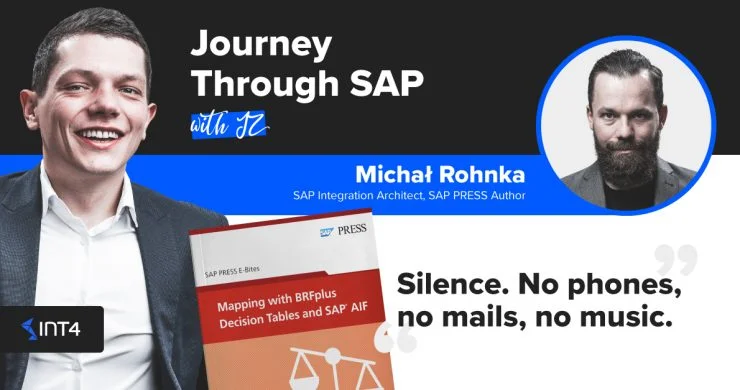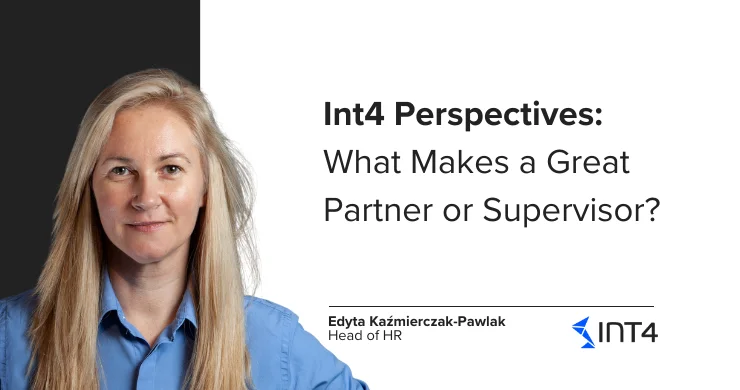Silence. No phones, no mails, no music.

Let me introduce my guest
My today’s interlocutor is an SAP NetWeaver consultant and solution designer with an overall more than 10 years’ experience as SAP ABAP Consultant (BRFPlus, AIF, ABAP for HANA). Experienced in SAP integration techniques (SAP PI/SAP BC, AIF, ALE and EDI related ERP configuration, SAP CPI) and advanced ABAP programming.
While scrolling through the SAP Press Books Hall of Fame you will come across 11 positions written by Int4 Team. One of the authors is Michał Rohnka (SAP Integration Architect) who has had his own contribution into the SAP community by sharing his knowledge with the readers. To celebrate the National Book Author’s day, I am asking Michał not only a bit about his book but about what it is like to write a book as well. Michał Rohnka is interviewed by Jarosław JZ Ziółkowski.
Reading time: 5 minutes
1. You are the author of “Mapping with BRFplus Decision Tables and SAP AIF” that SAP Press Books published in 2020. Let’s start with explaining what BRFplus, SAP AIF are and who they are for.
BRFplus is a framework that is used to define business rules. Business rule in this context is for example a decision which mapping table should be used for a given company and message type. Usage of the mapping table itself is a rule, too. You decide what value should be mapped to what value. These can of course be more complex, then one table one value.
AIF is also a framework but it’s designed to help with interface implementation and monitoring.
What I like most about these two is that they are both trying to bring technical guys (like myself) closer to business users and vice versa increase business users engagement in the technical part of the processes they are part of. What’s more they are working together really well when you have an interface that requires business rules.
2. Writing a book is not something that we do on a daily basis and it can be seen by many as a trip to the moon. When did you first realize you wanted to write a book?
To be honest, Michal Krawczyk (SAP Mentor and Int4 Board Member) encouraged me to do this. He, as my mentor, encourages knowledge sharing a lot, being an amazing example at the same time. So, I would say he sowed it in me and it grew over time. I would describe it as more of a process thing then a sudden overnight revelation.
3. As we have celebrated a National Author’s Day on the 1st of November, could you share with the readers what is your writing process like?
Writing a technical book, while being a person like I am, is all about being sure that what you are writing is really the truth and it will work. So, I’ve done all the examples, tests and prepared all kinds of variations before I’ve even started. You can say I’ve done a project for myself; and it must have been a successful one (laughter). After that, I’ve described in detail, step by step, what I’ve done. Working with SAP Press editor was also really helpful, especially for me writing for the first time.
4. Right, it was your first piece of writing. Out of curiosity, what part of the book did you have the hardest time writing?
Introduction and first chapter describing most basic parts were quite challenging. I’m a very technically oriented person and I always want to jump to the “hard part” which means the most exciting part for me.
5. I assume that by hard part you mean complex analysis, interface and simple solutions, right. Well, how would you describe your book’s ideal reader then?
It’s for all the people that would like to learn something about building business rules and find out that those could be more complex than simple value mapping.
Someone who tries to do the complex interface that will be a real engine with all flexibility you can get in such a situation could also benefit much from reading it.
6. You have mentioned that you had done all the examples, tests and prepared all kinds of variations first before you even started writing the book. Going deeper into this, did you need to do any research for your book?
It was much more experience than research for me. I had most of the knowledge when I started writing and needed only a couple of detailed investigations. I believe that awareness of the fact that I had all that I needed to write the book was the green light for me to do this.
7. A more personal question, if I may ask about your routines and habits while writing. What do you need in your writing space to help you stay focused?
Silence. No phones, no mails, no music.
8. Sounds like a challenge itself these days (laughter). Any advice that you would give to a writer working on their first book?
Be patient, describe everything in detail and think about the readers. You are not writing for yourself. Prepare yourself for a ton of correction requests from the editor, there is no way around it. They know their job and they will make your book much better.
9. We are talking about the book that you wrote, however, my last question would be about your favourite book that you would highly recommend for the Business.
It will be Testing SAP APIs: Strategy and Execution written by three great guys Pontus Borgstroem, Michał Krawczyk and Korneliusz Kordus. It’s showing us how we should approach our integration projects, that it’s really important to think about all test phases and support models right from the start, not when all is set and done. It’s definitely a really good piece of writing and well of knowledge for everybody involved in integration from developers, through architects to project managers.
Read also:
1. Is every new project like returning to university?
2. You should get your hands dirty with ABAP code before you start creating IT solutions
Popular tags
ABAP int4 INT4 IFTT Int4Interview S/4HANA SAP AIF SAP CPI sap integration


